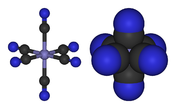- Cyanometalate
-
Cyanometallates are a class of coordination compounds, most often consisting only of cyanide ligands.[1] Most are anions. Cyanide is a highly basic and small ligand, hence it readily saturates the coordination sphere of metal ions. The resulting cyanometallate anions are often used as ligands for building more complex structures called coordination polymers, the best known example of which is Prussian blue, a common dyestuff.[2]
Contents
Examples
Homoleptic cyanometallates
Homoleptic cyanometallates refers to complexes where the only ligand is cyanide. For the first row transition metals, well known homoleptic cyanometallates are the hexacyanides. Hexacyanometalates are known for Ti(III), V(III), Cr(III), Mn(III), Fe(II), Fe(III), and Co(III). Other more labile derivatives are known as well. The Mn(III), Fe(II), Fe(III), and Co(III) derivatives are low-spin, reflecting the powerful donor properties of cyanide, i.e. cyanide ranks highly in the spectrochemical series.
Several tetracyanometalates are also known, the best known being those of the d8 metals, Ni(II), Pd(II), and Pt(II). These species are square-planar and diamagnetic. The coinage metals form stable dicyanometallates, [Cu(CN)2]-, [Ag(CN)2]-, and [Au(CN)2]-. For heavier metals, other stoichiometries are known such as K4Mo(CN)8. Some cyanometallates are clusters featuring metal-metal bonds, such as [Mo2(CN)8]4-.
Heteroleptic cyanometallates
Mixed ligand cyanometallates have been prepared, one example is the zero-valent [Fe(CO)4(CN)]-. Only few heteroleptic cyanometallates are rarely of interest outside of the research laboratory, one exception being the drug sodium nitroprusside (Na3FeNO(CN)5).
Synthesis
Because cyanide is a powerful nucleophile and a strong ligand, cyanometallates are generally prepared by the direct reaction of cyanide salts with simple metal salts. If other ligands are present on the metal, these are often displaced by cyanide. By far the largest application of cyanometalates is the production of [Au(CN)2]- in the extraction of gold from low grade ores. This conversion involves oxidation of the gold:
- 4 Au + 8 CN- + O2 + 4 H2O → [Au(CN)2]- + 8 OH-
Reactions
Redox
Because the M-CN bond is strong, several cyanometallates can sustain redox. A well known couple is [Fe(CN)6]3-/4-. Few unidentate ligands allow similar redox transformations wherein both members of the redox couple are observable in solution. Another perhaps more dramatic example is the 2e reduction of the square planar tetracyanonickelate to its tetrahedral Ni(0) derivative:
- Ni(CN)4 + 2 e → [Ni(CN)4]4-
N-Centered reactions
Many characteristic reactions of metal cyanides arise from ambidentate nature of cyanide, i.e. both the nitrogen and the carbon termini of the anion are basic. Thus cyanometalates can be alkylated to give isocyanide complexes.[3] Cyanide ligands are susceptible to protonation, hence many cyanometalates are highly solvatochromic. The nitrogen terminus ia a good ligand for other metals. The latter tendency is illustrated by the condensation of ferrocyanide salts with other metal ions to give polymers, such as Prussian blue. Such polymers feature Fe-CN-M linkages.
References
- ^ Sharpe, A. G. The Chemistry of Cyano Complexes of the Transition Metals; Academic Press: London, 1976. ISBN 0126384509.
- ^ *Dunbar, K. R. and Heintz, R. A., "Chemistry of Transition Metal Cyanide Compounds: Modern Perspectives", Progress in Inorganic Chemistry, 1997, 45, 283-391.
- ^ Fehlhammer, W. P. Fritz, M., "Emergence of a CNH and Cyano Complex Based Organometallic Chemistry", Chemical Reviews, 1993, volume 93, pp. 1243-80.doi:10.1021/cr00019a016
Categories:- Transition metals
Wikimedia Foundation. 2010.


